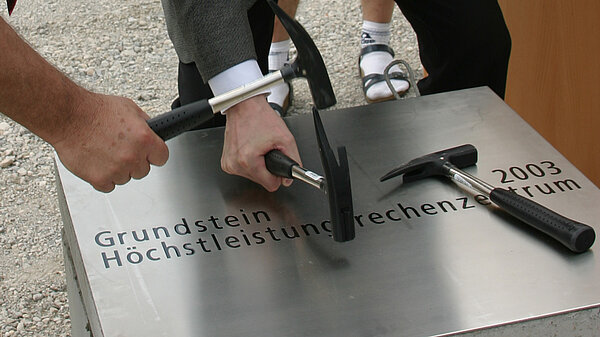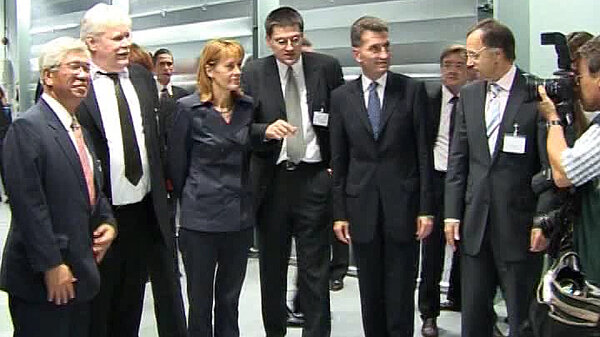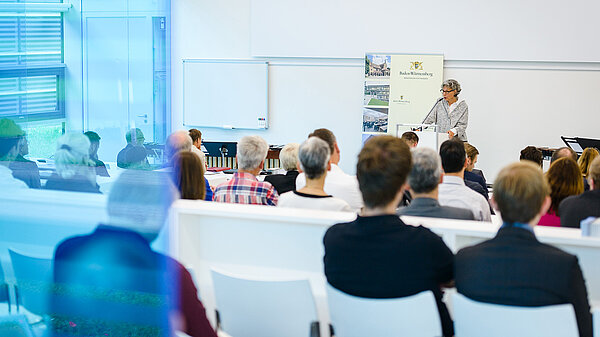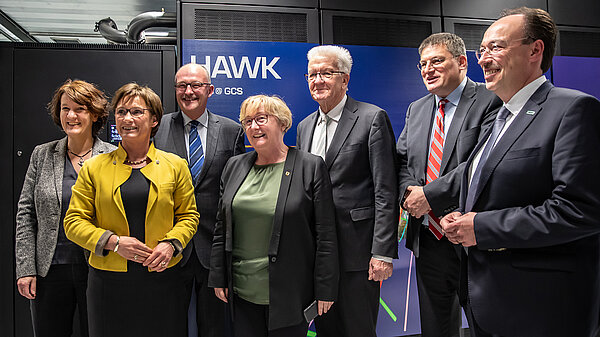High-Performance Computing Center Stuttgart
Founded in 1996 as Germany's first national high-performance computing (HPC) center, the High-Performance Computing Center Stuttgart (HLRS) has grown to become not just a key facility of the University of Stuttgart but also an internationally prominent center for research involving simulation, visualization, and data analytics. This timeline highlights some key milestones in the center's history.
Baden-Württemberg Prime Minister Lothar Späth approves funding for a Cray 2 supercomputer, establishing Stuttgart's reputation as a center for high-performance computing (HPC). At the time, high-performance computing is primarily used for nuclear power, aeronautics, and aerospace research.
Baden-Württemberg Prime Minister Erwin Teufel and Edzard Reuter, Chairman of the Board at Daimler-Benz AG, establish Höchstleistungsrechner für Wissenschaft und Wirtschaft GmbH (HWW). HWW for the first time ever brings industry and science together in one company for the use of supercomputers, establishes a sustainable business model, and gives Daimler and Porsche direct access to the fastest computers in the world.

Prime Minister Teufel founds the High-Performance Computing Center Stuttgart (HLRS) at the University of Stuttgart as Germany's first national high-performance computing center. HLRS is a division within the computing center of the University of Stuttgart, and Prof. Rühle is named director. At the founding ceremony, HLRS also announces the beginning of production of a new Cray supercomputer. At the time of its inauguration, the new system is the 7th fastest supercomputer in the world.
HLRS initiates the first European project for metacomputing (METODIS). Its success convinces the EU to create its own funding stream for metacomputing and grid computing., and establishes HLRS as a leading HPC research center at a Europe-wide level.
In partnership with the Pittsburgh Supercomputing Center (USA), HLRS for the first time connects two supercomputers to solve a simulation problem. In recognition of the achievement, HLRS receives an award from the US National Science Foundation (NSF) for Real Distributed Supercomputing.

Prof. Rühle steps down as HLRS director and hands leadership over to Prof. Michael Resch.
HLRS wins the HPC Challenge at the SC Supercomputing Conference in Phoenix, USA.
Baden-Württemberg Prime Minister Günther Oettinger welcomes a new HLRS supercomputer, an NEC SX-8, and opens the center's new building on Nobelstraße. For the first time, an HLRS computing system achieves performance at the teraflop scale.

HLRS is cofounder of D-Grid, an initiative to network all German high-performance computing centers.
The State of Baden-Württemberg and the German federal government agree to finance HLRS for an amount 133 million Euros over 10 years under the auspices of the PetaGCS project.
HLRS, together with supercomputing centers in Munich and Jülich, founds the Gauss Centre for Supercomputing (GCS).
Together, the three centers join the Partnership for Advanced Computing in Europe (PRACE) and begin providing computing resources to scientists from across the EU.
At the state level, HLRS launches BW-Grid and finances supercomputers at six locations across Baden-Württemberg.
HLRS participates in the Excellence Cluster "Simulation Technology" (SimTech) with the center's director serving as a principal investigator. The excellence cluster and its renewal both receive positive performance reviews and continue until 2025.
With the creation of the Automotive Solution Center for Simulation (ASCS), HLRS founds its first Solution Center. This is followed in 2018 with the establishment of the Media Solution Center, and a Medical Solution Center is planned to start operation in 2022.
In cooperation with the Karlsruhe Institute of Technology, HLRS founds SICOS BW in order to coordinate operations between the two centers and to facilitate access to simulation technologies among small and medium-sized enterprises.
HLRS's power and cooling building begins operation.
With support of the State of Baden-Württemberg, HLRS starts Simulated Worlds, an outreach project designed to bring the theme of simulation into schools.

Baden-Württemberg Prime Minister Winfried Kretschmann celebrates the start of operation of a new Cray XE6 supercomputer at HLRS. The system is christened with the name Hermit (after the Hermit beetle) and for the first time at HLRS achieves a performance of 1 Petaflop. In the coming years, the system is expanded and renamed Hornet (2014) and Hazel Hen (2015).
HLRS opens its new Research Building.
HLRS commits itself to sustainability and starts its first, state-funded sustainability project.
HLRS creates a working group focusing on the theory of science and the societal relevance of simulation. A state-funded projects on these themes begins in 2016.
The State of Baden-Württemberg and German federal government agree to financing in the amount of 153 million Euros for HLRS for the coming 10 years under the auspices of the project SiVeGCS.
HLRS celebrates the opening of its new HPC training building.
HLRS establishes a sociopolitical advisory board tasked with considering important themes and questions that affect society and to determine how HLRS could help to address them. The group is created in recognition of the fact that simulation is not only important for science and industry, but is important and useful for society at large.
HLRS assumes leadership of two European Centers of Excellence focused on the engineering sciences (EXCELLERAT) and global systems science (HiDALGO).

Prime Minister Kretschmann inaugurates HLRS's next-generation supercomputer, an HPE Apollo system named Hawk.
In recognition of its comprehensive environmental management system, HLRS receives certification under the Blue Angel Ecolabel and the Eco-Management and Audit Scheme (EMAS).
HLRS is named coordinating center for the EuroCC and CASTIEL projects, which are created to promote the development of HPC expertise across all of Europe. The projects establish HLRS as playing a leading role in HPC across the entire EU.
Together with the German Federal Institute for Population Research (BiB), HLRS produces daily simulations to predict demand for intensive care unit beds resulting from the COVID-19 pandemic. Beginning in November 2020, the results are submitted daily to the Federal Health Ministry and Federal Ministry of the Interior. The project marks the first time that a federal ministry uses HPC for simulation. The collaboration was later recognized with an HPC Innovation Award.
HLRS celebrates its 25th anniversary, reflecting on the history and future challenges of high-performance computing.
HLRS cofounds CASE4Med, a medical solution center that will improve access to simulation, data analytics, and artificial intelligence resources for developers and manufacturers of medical products.
HLRS and WIKKI GmbH win an HPC Innovation Excellence Award for development of the coherent file format, which makes it possible to run much larger simulations using OpenFOAM.
HLRS achieves ISO 27001 certification for information security management.
HLRS begins coordinating HammerHAI, funded through the the EuroHPC Joint Undertaking as one of seven European AI Factories.
HLRS Wins a Datacenter Strategy Award for "Transformation“ in recognition of its sustainable computing center strategy and its new construction project, HLRS III.
HLRS celebrates the inauguration of Hunter, its newest supercomputer.